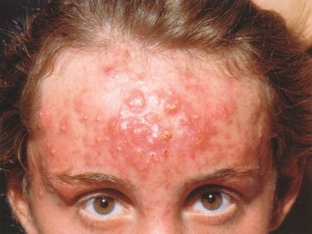Acne inversion is a particularly unpleasant manifestation of acne. They can be considered to some extent a complication of acne, since this is a secondary inflammatory process that develops against the background of already existing acne vulgaris.
Some experts consider acne inverse to be a form of chronic pyoderma, since several acne elements can communicate with each other through fistulous tracts. In any case, the patient with inverse acne requires a special approach, & nbsp; because this disease greatly reduces the quality of his life.
What are the causes of acne inversion
The peculiarity of the disease is that inverse acne affects only the apocrine glands – those sweat glands that are located in the inguinal and axillary regions, in the navel and chest areolas, and begin to function after puberty.
Provoking factors contributing to the development of inverse acne are:
- overweight,
- damage and pressure from clothes on the skin in the area of concentration of apocrine glands,
- scratching caused by itching in the groin or armpits.
Inverted acne can complicate the course of acne by the fact that inflamed sebaceous glands & nbsp; and hair follicles can burst and cause secondary infection of the inflamed apocrine gland.
In addition, the purulent contents coming out of inverse acne also become a source of re-infection and the cause of the formation of new acne. In addition, fistulous passages that form with apocrine glands can intertwine and connect several acne elements, significantly complicating the course of the disease.
Signs of development and inflammation of acne inverse
The essence of the process of formation of inverse acne is that initially inflammation covers the hair follicle or sebaceous gland, then the follicles, inflamed and enlarged in size from purulent contents, compress the nearby apocrine glands.
Due to the compression that has begun, the sweat gland accumulates sweat particles and other elements that cannot be brought out, becomes inflamed, suppurates. This is manifested by dense subcutaneous tubercles, then fistulous passages are formed, through which the contents of mature abscesses exit.

On palpation, the subcutaneous tubercles are painful, there are many of them and they gradually increase in size. The infiltrate emerging from the fistulous passages can be purulent-bloody, then the abscess heals, and a scar forms in its place.
The process of scarring of inverse acne may be accompanied by secondary infection, and then new acne elements appear next to the scar, and the area of skin lesions gradually expands.
Peculiarities of treatment and prevention of inverse acne
Therapy for acne inversion is directed from one side – to remove the inflammatory process, and on the other – to prevent blockage of apocrine glands and improve cell metabolism.
The basis of treatment for inverse acne is antibiotic therapy, and it is desirable to select the drug on the basis of laboratory tests that show the sensitivity of the inoculated microflora to certain types of antibiotics. According to the indications, antibiotics are combined locally and orally.
A good effect in the treatment of inverse acne is given by the combination of local antibacterial drugs with benzoyl peroxide, which improves the oxygenation of the affected tissues, is a good keratolytic, slightly suppresses the production of sebum and accelerates the granulation of inflammatory elements on the skin. Additional use of retinoids, hormonal therapy is possible.
A patient with acne inversion must clearly understand that the treatment will be long, lasting for months and will become effective only if the recommendations of the dermatologist regarding the regimen of medication, salon cleansing procedures, use of home skin care products are strictly followed.







Add a comment